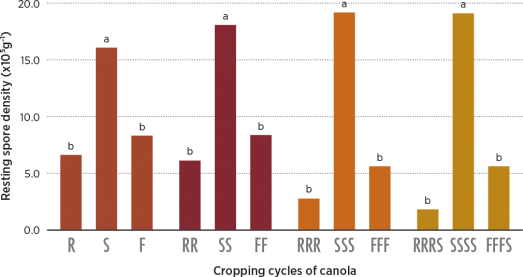How to protect clubroot resistance
Clubroot is a soil-borne disease caused by Plasmodiophora brassicae. It’s an emerging threat to canola production. Results of this study show that effective clubroot management relies on cultivar resistance in combination with management practices that reduce viable resting spore populations. lubroot is a soil-borne disease caused by Plasmodiophora brassicae. It’s an emerging threat to canola production. Results of this study show that effective clubroot management relies on cultivar resistance in combination with management practices that reduce viable resting spore populations.
Originally identified near Edmonton in 2003, clubroot has since spread to nearly 2,000 fields across Alberta. It has been detected in Saskatchewan and has been confirmed through soil testing in several municipalities in Manitoba. Yield losses in severely diseased fields have ranged from 30 to 100 percent. Clubroot resting spores can remain in the soil for many years, and mitigation is required to minimize the impact to grower and industry profitability.
Researchers at the University of Alberta and AARD conducted a four-year study to: provide tools to slow the spread of clubroot on the Prairies; develop effective soil fumigation methods to hinder establishment of the disease; and provide information to help growers optimize rotation strategies and improve stewardship of clubroot resistance.
Through a combination of field trials, mini-plot trials using naturally infested field soil and greenhouse trials, this study specifically examined the effects of clubroot-resistant canola lines on soils infested by Plasmodiophora brassicae.
Experiments were conducted on crop rotations planted in clubroot-infested soils as follows:
- Field tests: continuous canola; canola-pea-wheat-canola; canola-oats-pea-canola; canola-oats-wheat-canola; canola-barley-pea-canola; canola-fallow-fallow-canola
- Three-year mini-plots: continuous susceptible canola (S); pea-wheat-S; barley (B) -pea-S; oats-wheat-S; fallow (F) -F-S
- Four-year mini-plots: resistant canola (R) -R-R-S; R-R-B-S; R-B-B-S; B-B-B-S As expected, soil pathogen popula-tions were higher after the susceptible cultivar (45H26) when compared to the resistant cultivar (45H29). At the end of the four-year susceptible-resistant cropping sequence, disease severity was 10 times higher in the continuous S than in the R-R-R-S rotation. Resting spore numbers were higher after each cycle of the continuous S rotation and decreased throughout the F-F-S and R-R-R-S sequences.
Continuous planting of canola resulted in greater clubroot severity than all other treatments in the field trials, and seed yield was higher in the canola-oats-peas-canola rotation than all others.
Overall, introduction of a susceptible cultivar resulted in greater P. brassicae spore populations in the soil, higher disease levels and increased infection.
Greenhouse trials also showed that increased P. brassicae soil populations significantly reduce plant growth and yield.
Further study of clubroot continues under AAFC’s Growing Forward 2 program. “Management of clubroot in a dynamic environment,” and “Clubroot surveillance and epidemiology: staying ahead of an important canola issue,” also led by Hwang and Strelkov, aim to: provide critical information about the nature and extent of the clubroot outbreak in Canada; further investigate the impact of cropping resistant canola; evaluate the effectiveness of soil fumigants; and improve clubroot sanitation protocols.
Hwang also leads the grower-funded study titled “Toward a strategy for reducing the spore density and dissemination of clubroot of canola in Alberta,” currently in the second of four years. One objective of this study is to develop methods to reduce newly established infestations. In greenhouse and field experiments, use of Vapam fumigant on clubroot-infested land has reduced clubroot severity and improved crop establishment, plant height and seed production.
Conclusion
Agronomy recommendations based on this study:
- Manage infected fields through crop rotation combined with the use of resistant varieties.
- Practice good sanitation to restrict the movement of possibly contaminated material — resting spores are most likely to spread via contaminated soil and infected canola plant parts.
- Consider including the application of nutrient supplements (such as calcium and boron), soil fumigants and fungicides.

Changes in resting spore concentration over cropping cycles with resistant (R, ‘45H29’, Pioneer Hi-Bred) or susceptible (S, ‘45H26, Pioneer Hi-Bred) canola cultivars, or a fallow (F) treatment. The fallow conditions were maintained over the same period in which three cycles of resistant or susceptible canola was cropped. In year four, the same susceptible (S) variety was grown on all three treatments to compare clubroot risk.




